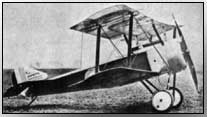The War in the Air - Fighters: Spad, Pup and Albatross, the Intermediate Generation
 The desire for stable, easy-to-fly aircraft had given way to a call for
manoeuvrable fighters with fixed
machine guns and a good rate
of climb.
The desire for stable, easy-to-fly aircraft had given way to a call for
manoeuvrable fighters with fixed
machine guns and a good rate
of climb.
It was clear on both sides of the trenches that the current aircraft were not adequate. By autumn of 1916 the first custom-built tractor fighters began to appear on the front. The most successful British fighter of this period was the Sopwith Pup with a single synchronized (i.e. controlled by an interrupter gear) machine gun and powered by a rotary engine.
The French Spad VII also had a single synchronized Vickers gun, but used a more powerful inline engine, and as did the German Albatros D I and D II, which were armed with twin synchronized guns.
Late in 1916 Oswald Boelcke was killed in a collision with another German aircraft. German and Allied imagination was soon captivated by a new rising star. A month after Boelcke's death Manfred von Richthofen, a protégé of Boelcke's, shot down the British ace Lanoe Hawker.
In celebration he decided to paint his Albatros entirely red, from which stems his nickname of "The Red Baron". Soon after this he was given command of Jasta (Squadron) 11. In spring of 1917 the Albatros D III arrived at the front. It was a development of the earlier Albatros planes, but with a smaller lower wing that was inspired by the Nieuport Bebe.
Control of the air was returning to the Germans. April was particularly disastrous to the allies, and became known as "Bloody April". Jasta 11 alone accounted for over 80 planes, an astonishing 21 of these being shot down by Richthofen himself. The British lost 75 aircraft in the first week.
The average lifetime of a pilot as the front was a mere two months, hardly surprising considering that at this time the RFC was sending pilots to the front with little more that 17 hours tuition behind them.
Richthofen's success prompted the Germans, in June, to promote him to command a fighter wing comprising four different squadrons. He recruited the best pilots to Jagdgeschwader I, (JG I) which quickly became famous, or infamous, depending on which side of the lines you were.
All the pilots painted their plans in bright colours, and JG I soon earned the nickname of "The Flying Circus". Rather than being located at the one spot, the Germans moved this crack unit up and down the front.
Article contributed by Ari Unikoski
Next - Fighters - From Triplane to Camel, the War's Best Fighters
"Wipers" was the British nickname for the Belgian town Ypres.
- Did you know?
